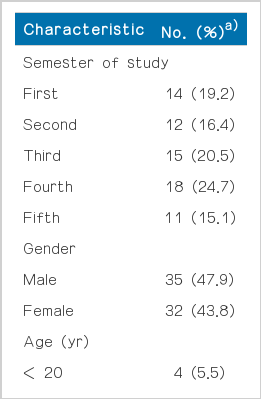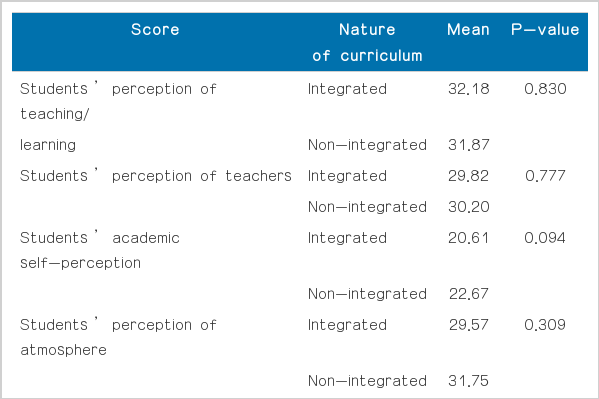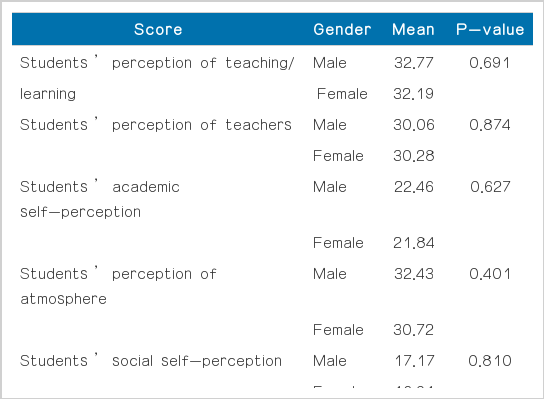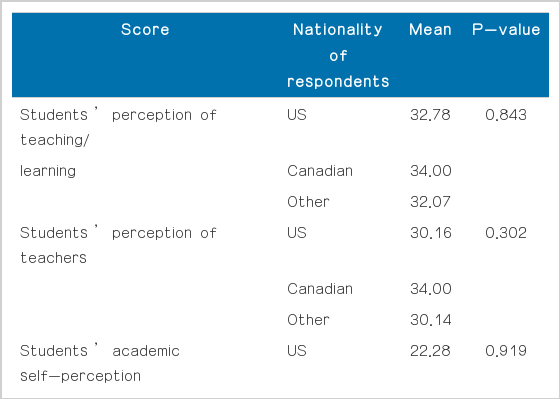Students’ perception of the learning environment at Xavier University School of Medicine, Aruba
Article information
Abstract
Purpose:
The learning environment at Xavier University School of Medicine (XUSOM), Aruba has not been previously studied. Hence, the present study was carried out using the Dundee Ready Education Environment Measure (DREEM) to obtain student perceptions about the learning environment and compare the same among different subgroups of respondents.
Methods:
The questionnaire was administered to undergraduate medical students in their first to fifth semester during the first two weeks of June 2013. The students’ perceptions were evaluated by noting their degree of agreement with a set of 50 statements using a Likert-type scale. The mean overall score and the scores of subcategory were calculated and compared among different respondents (P<0.05).
Results:
Seventy-three of the 86 students (84.9%) completed the questionnaire. The overall mean±SD score was 131.79±22.86 (maximum score 200). The mean±SD score for students’ perception of teaching/learning was 31.99±6.23 (maximum score, 48), while the score for students’ perceptions of teachers was 30.05±5.54 (maximum score, 44). The mean±SD scores for students’ academic self-perception, students’ perception of the atmosphere, and students’ social self-perception were 21.88±5.11 (maximum score, 32), 30.92±8.59 (maximum score, 48), and 16.96±4.71 (maximum score, 28), respectively. There were no differences in scores according to the respondents’ personal characteristics.
Conclusion:
The student responses about the learning environment at the institution were positive. We plan to obtain regular student feedback as the curriculum becomes progressively more student-centered and integrated.
INTRODUCTION
The Dundee Ready Education Environment Measure (DREEM) is widely used to evaluate the educational climate in health and medicine [1]. Xavier University School of Medicine (XUSOM) at Aruba, Kingdom of the Netherlands admits students mainly from the United States (US) and Canada to the undergraduate medical (MD) program. Students spend five semesters at Aruba and then do their clinical rotations in the US. Recently, modifications have been made to the basic sciences MD program [2]. The school has shifted to an integrated organ system-based curriculum from the January 2013 semester. Normal human structure and function are taught during the first two semesters and abnormalities in structure and function during disease during the next two. Problem-based learning (PBL) sessions, sessions on critical appraisal of the scientific literature, and early clinical exposure have been introduced. The assessment system was modified to include more formative assessment and assessment of attitudes and professionalism. Student feedback about the educational environment using a standardized instrument has not been previously carried out in the institution. Hence, the present study was carried out to obtain student perceptions about the learning environment and to compare their perceptions according to demographic characteristics of the respondents using DREEM.
METHODS
The DREEM questionnaire was administered to the first, second, third, fourth, and fifth semester students of XUSOM during the first two weeks of June 2013. A semester is of 15 weeks duration, and the college admits students three times a year. Students are admitted to the Spring semester in January, to the Summer semester in May, and the Fall semester in September of each year. The questionnaire was administered to the students during school working hours. The authors explained the aims and objectives of the study to the students and invited them to participate. Written informed consent was obtained from all of the respondents. Student perceptions about the educational environment were studied using the DREEM questionnaire described in a previous study [1]. The study was approved by the Institutional Review Board of the institution through notification number XUSOM/IRB/2013/02.
Basic demographic information including the semester of study, gender, age, nationality, and occupation of the parents was noted. The students’ perception about the educational environment was studied by noting their degree of agreement to a set of 50 statements using a Likert-type scale. The statements were grouped together under five categories: students’ perception of teaching/learning, students’ perception of teachers, students’ academic self-perception, students’ perception of the atmosphere, and students’ social self-perception. Certain statements were negatively worded and their scores were reversed for further analysis.
The data from respondents who filled in more than two personal characteristics were included in the study. Those who filled in two or fewer characteristics were excluded from the study. There were two respondents in this category and their results were omitted. Hence, the total number of respondents who successfully completed the study was 73 (out of a total of 75 respondents). The data was entered into SPSS ver. 20 (IBM Co., Armonk, NY, USA) for further analysis. The total scores in different subcategories and the overall score was calculated. The scores of individual statements were also noted. The normality of distribution of the scores was studied using a one-sample Kolmogorov-Smirnov test. The average scores were calculated among different categories of respondents using appropriate statistical tests. A P-value less than 0.05 was taken as statistically significant. Free text comments were also invited from the respondents and tabulated.
RESULTS
Seventy-three of the eighty-six students (84.9%) completed the questionnaires. Table 1 shows the demographic characteristics of the respondents. A large number of students were of US nationality. Certain respondents did not provide all the required demographic characteristics. The overall mean±SD score was 131.79±22.86 (maximum score, 200). The mean±SD score for students’ perception of teaching/learning was 31.99± 6.23 (maximum score, 48), while the score for students’ perceptions of teachers was 30.05±5.54 (maximum score, 44). The mean±SD scores for students’ academic self-perceptions, students’ perception of atmosphere, and students’ social selfperceptions were 21.88±5.11 (maximum score, 32), 30.92±8.59 (maximum score, 48), and 16.96±4.71 (maximum score, 28), respectively.
Individual statements with mean scores less than 2.5 were noted as areas of concern and those less than 2 as those which would need improvement. Among these were ‘The teaching is too teacher-centered’ and ‘The teaching overemphasizes factual learning’ which had mean scores of 1.78 and 1.57, respectively. The statements were negative, and their scores had been reversed while calculating the final score. The statement ‘I am too tired to enjoy this course’ also had a reversed score of 1.94. Other statements with scores below 2.5 were: ‘The teachers ridicule the students’ (2.29), ‘The teachers are authoritarian’ (2.08), ‘The students irritate the teachers’ (2.27), ‘I am able to memorize all I need’ (2.36), ‘The atmosphere is relaxed during the teaching’ (2.43), ‘This school is well time-tabled’ (2.15), ‘There is a good support system for students who get depressed’ (2.2), and ‘I seldom feel lonely’ (2.33).
Tables 2-4 show the mean scores according to the nature of the curriculum, gender of the respondents, and their nationality. There were no significant differences in scores according to these characteristics. Among the free text comments, there was a request for access to course material and power point slides through the internet (at present they can be accessed only from the campus), a request for student transportation, and certain specific comments concerning teaching by specific teachers. These comments were made by only one respondent each.
DISCUSSION
This study provides an overview of the learning environment at our institution. The participation of the third semester students was low. Participants did not answer all of the questions related to demographics. This may be because they were apprehensive about being identified in a school with a small student body. The mean overall score was 131.79, and there was little variation in the overall score or the subscores according to the demographic characteristics of respondents.
Our study was conducted only among students during the basic science years, as the clinical years of training are undertaken in various hospitals in the US, as is the case in most Caribbean medical schools. The area of concern noted in our study was the fact that the respondents regarded teaching as being too teacher-centered and overemphasizing factual learning. XUSOM is at present changing over to an integrated, student- centered curriculum, and PBL sessions and student activities have been introduced. Small group learning is emphasized, and we believe this will address the problem. The feedback has also been shared with faculty members to bring about modifications in their behavior. The students’ perception that teachers are authoritarian and that they ridicule the students has been noted in many previous studies in other countries [3-6].
Recently, the school has also been shifting from a disciplinebased to an integrated, organ system-based curriculum. Previously the school had a fixed timetable throughout the semester. Considering the need for curriculum integration and other issues, faculty members have been meeting every fortnight to finalize the following two week’s timetable. Initially, there were some problems in communicating this in time to the students, which may have accounted for the low score for the statement ‘This school is well time-tabled.’ The reversed score for the statement ‘I seldom feel lonely’ and the scores for ‘I am rarely bored on this course’ and ‘There is a good support system for students who get stressed’ were low. At present there is no central housing facility in the institution, and the school helps students with renting houses. Therefore, students and faculty members may feel isolated. The school is in the process of shifting to a new campus with housing for both faculty and students, which may reduce the problem. The school has recently hired a clinical psychologist to help students who feel stressed. Students have a faculty advisor who advises them on different aspects of their studies and general life, but this person is not specifically trained in counseling.
Students access course material through a system called ‘Class Notes,’ which can, however, only be accessed from the campus. We are considering providing access to all course material through an online platform. In the new campus, housing accommodations for a few students have been provided, and transportation from the school to the housing area is being provided.
The strength of this study is the high response rate and the use of a validated instrument, DREEM, to measure student perceptions. Our results may have implications for other medical schools: Many ‘offshore’ medical schools in the Caribbean admit students mainly from the US and Canada to the MD program [7]. The first four or five semesters of the program are conducted in the Caribbean, and the clinical rotations are done in the US. The findings of our study about teaching being too teacher-centered and about student difficulties in coping with a demanding course of study would also be true for other schools. The issues of perceived problems in student support and counseling may also be true of other schools. In the Caribbean, many schools do not have residential facilities for students and faculty, which results in students’ having to arrange their own accommodations and being scattered throughout the island, which may be partly responsible for the feeling of loneliness.
Many schools all over the world teach the basic sciences in an integrated manner with early clinical exposure [8,9]. The major teaching-learning method in many schools continues to be lectures supplemented by problem-based learning sessions, small group learning, and other student-centered approaches. Curriculum integration in many schools is at the level of the organ system and often is difficult to achieve. Students, especially in the early years of study, have difficulty in coping with a demanding course of study, and support facilities in many schools need to be improved. Thus, the findings of our study could inspire educators in other geographic areas to study the strengths and weaknesses of the learning environment in their schools and gather information which could be used to improve the situation.
This study had limitations. Student perception of the learning environment was studied using DREEM, and the information was not compared with that obtained from other sources. The response rate of the third semester students was low. Certain respondents did not complete all the required demographic characteristics. Hence, comparison, especially according to the nationality of respondents and occupation of parents, may not be representative of the student population.
In conclusion, the student response about the learning environment at the institution was positive. We are confident the scores will improve as the curriculum and support systems develop. With the introduction of problem-based learning, small group sessions and activities, learning will become more student-centered and students will assume greater responsibility for their own learning. We plan to obtain regular student feedback as the curriculum becomes progressively more student- centered and integrated.
Notes
CONFLICT OF INTEREST
No potential conflict of interest relevant to this article was reported
Supplementary material: authors’ explanation of their paper in an audio recording of the author speaking.




